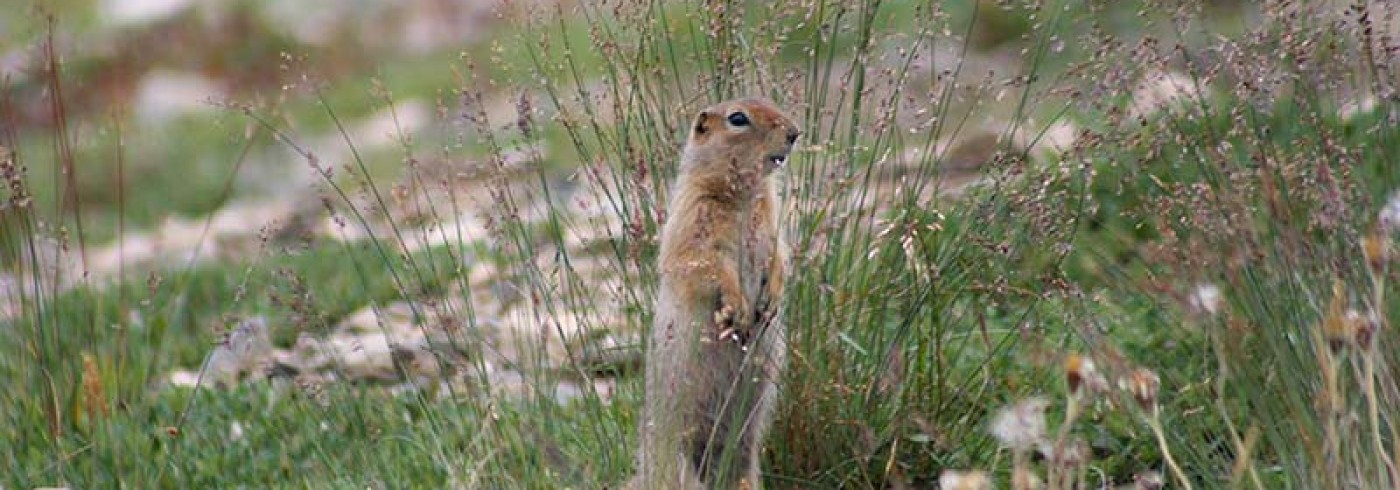Palatability and colour patterns in the Norwegian lemming
Most small mammals are for obvious antipredator reasons cryptically coloured. The Norwegian lemming (Lemmus lemmus) is an exception to this rule in that it is contrastingly patterned in orange-yellow, white, and black. At times, especially when lemmings are abundant and on the move, their behaviour is far less evasive and more aggressive than that of other rodents. These features, contrasting fur patterns and ”intrepidity”, are typically associated with strong defensive capabilities (spines, poisonous bites, foul smell/unpalatability) in animals. Although most common in invertebrates, such aposematism is known from all vertebrate classes. Andersson (1976) suggested that Norwegian lemmings are aggressive and capable of deterring (some) predators, which they advertise by means of conspicuous colours and noisy behaviour. Long-tailed skua (Stercorarius longicaudus) clearly preferred live grey-sided voles (Clethrionomys rufocanus) to Norwegian lemmings (Andersson 1976). Taitt (1993) suggested that a combination of crypsis and aposematism could explain colour patterns in the Norwegian lemmings, arguing that the rump gland in these animals produces a chemical deterrent, making it distasteful. This hypothesis was tested by Hansen (1993) for a number of predators (hawk owl (Surnia ulula), long-tailed skua, common gull (Larus canus), and others) and by Storbråten (1998) on stoat (Mustela erminea). Both authors presented simultaneously a Norwegian lemming and a Microtus-vole of similar sizes to the predator. Results showed an almost complete avoidance of lemmings as prey, supporting the aposematism hypothesis. Since all rodents presented were dead, behaviour could be ruled out as being responsible for the choice by predators. Furthermore, it has been reported that eating Norwegian lemmings may affect the predator adversely. Dogs and foxes often regurgitate devoured lemmings before any digestion has started (own observations). Hagen (1989) observed the same phenomenon in a selectively fed long-eared owl (Asio otus). He also noted a soap-like odour from pellets containing largely undigested lemming remains.
Aims of the study
Brown (Lemmus trimucronatus) and collared (Dicrostonyx groenlandicus) lemmings of north Canada are cryptic and actively hunted by many predator species. Because of this and the fact that most Canadian predators have no experience of Norwegian lemmings, I wanted to test if the distinct patterns of this species communicate the same message (distastefulness) to Canadian as to Scandinavian predators. Also, I wanted to see how predators reacted after having devoured Norwegian lemmings.
Field-work
Unfortunately, lemming predators were few in number during Tundra Northwest 1999’s second leg. At the first site, Ivvavik National Park, I tested the preferences of Arctic ground squirrels (Spermophilus parryii) on 4 August, but because the se omnivorous animals bring all food in to their burrows, I tied a fishing-line around the presented microtines so that they could be retrieved and inspected for signs of feeding. Squirrels brought both lemmings and voles underground and in only two cases had consumption started. In both cases the vale had been partly eaten and the lemming remained intact.
At Cape Bathurst, also on the mainland coast, there were good numbers of microtines but few predators. A pair of Arctic skua (Stercorarius parasiticus) were still feeding an almost fledged chick on 8 August, and these birds were offered a total of 11 lemming-vole pairs. Their preferences were random in that they took the lemming first in seven tests and the vole in four. Given the opportunity, skuas always returned to take the remaining rodent. However, since all prey were delivered to the chick, parents may have been less selective than if they themselves had eaten the prey. Despite a thorough search no pellets or rodent remains were found around the chick. The time that elapsed since the lemmings were eaten (
At the more northern sites, Banks, Melville, and Ellef Ringnes Islands, no tests were carried out because lemming predators were absent. At the Ellesmere site, a pair of glaucous gull (Larus hyperboreus) showed no interest in the lemming-vole pairs on offer, and on Devon Island two snowy owls proved too mobile and shy to study. During a short stop on 4 September at Iqaluit, the last site of the expedition, a flock of 30 northern ravens (Corvus corax) was offered rodents. Birds from this flock chose lemmings as first prey in four out of five tests, but in all cases the prey-carrying raven was chased by conspecifics and flew out of sight. I could therefore not study how the rodents were treated.
Preliminary conclusions
Out of a total of 18 tests, involving nine predator individuals, Norwegian lemming was the first choice in 11 (61 %) cases. This points to a random preference for Norwegian lemmings and Microtus-voles among Canadian predators. Given such unselective prey choice one would perhaps expect a slightly lemming-biased result due to the conspicuousness of this species. Ground squirrels, which may rely more on the sense of smell in food selection, avoided Norwegian lemmings but with only two observations no conclusion can be drawn. It may well be that predators have to learn that aposematic prey is distasteful through their own experience, especially if such species are similar to the predator’s normal prey.
Dates
Juni–September 1999
Participants
Principal investigator
Göran Högstedt
Institute of Zoology, University of Bergen
Norway
References
Andersson, M. (1976). Lemmus lemmus: a possible case of aposematic coloration and behaviour. Journal of Mammalogy, 57, 461-469.
Hagen, Y. (1989). Rovfuglene og viltpleien. Universitetsforlaget, Oslo, 540.
Hansen, G. (1993). Antipredator traits in the NorwegianLemming (Lemmus lemmus L.). Cand. scient. thesis. Univ. of Bergen, Norway.
Storbråten, G. K. (1998). Distribution, food selection and behaviour of stoat Mustela erminea L. in a
period of declining densities of small rodents. Cand. scient. thesis. Univ. of Bergen, Norway.
Taitt, M.J. (1993). Adaptive coloration in Lemmus lemmus: why aren’t Norwegian lemmings brown? In: The Biology of Lemmings (Stenseth, N.C. and Ims, R.A. (ed.), Academic Press, UK, 439-445.

